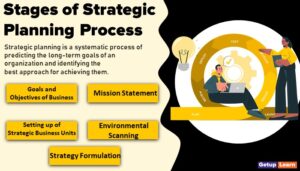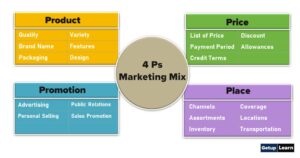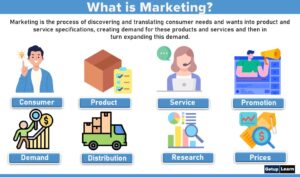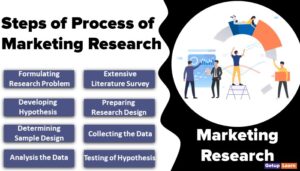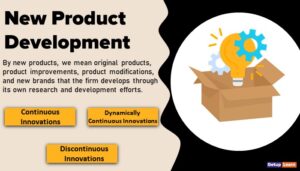Table of Contents
- 1 What is MIS?
- 2 Definition of MIS
- 3 Components of MIS
-
4 Types of MIS
- 4.1 Executive Information System (EIS)
- 4.2 Marketing Information System (MIS)
- 4.3 Business Intelligence System (BIS)
- 4.4 Customer Relationship Management System (CRM)
- 4.5 Sales Force Automation System (SFA)
- 4.6 Transaction Processing System (TPS)
- 4.7 Knowledge Management System (KMS)
- 4.8 Financial Accounting System (FAS)
- 4.9 Human Resource Management System (HRMS)
- 4.10 Supply Chain Management System (SCM)
- 5 Functions of MIS
- 6 Advantages of MIS
- 7 Difference Between MIS and Marketing Research
- 8 FAQ Related to MIS
What is MIS?
A marketing information system (MIS) is a continuing and interacting system of people, equipment, and procedures to gather, sort, analyze, evaluate, and distribute pertinent, timely, and accurate information for use by marketing decision–makers to improve their marketing planning, implementation, and control.
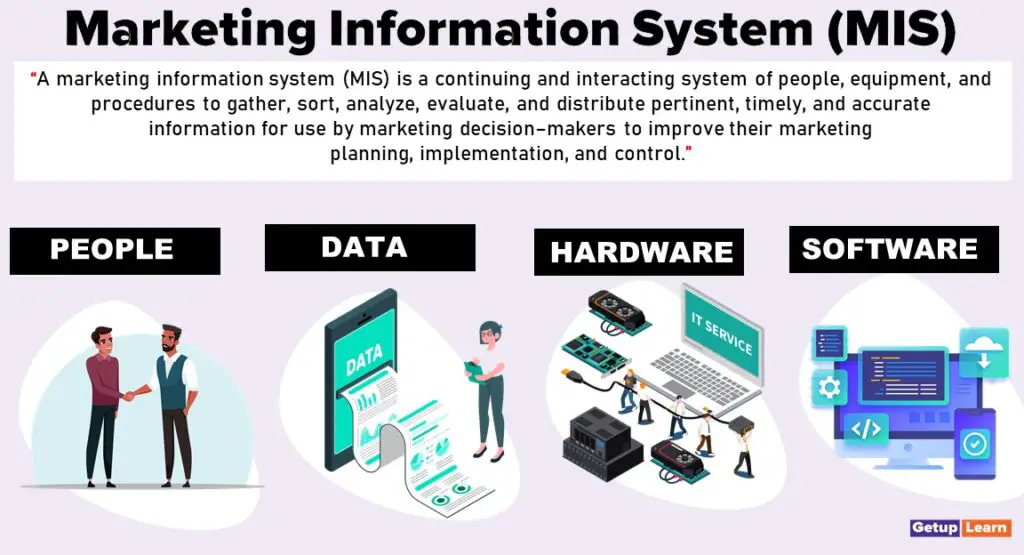
MIS is the use of information technology, people, and business processes to record, store and process data to produce information that decision-makers can use to make day-to-day decisions.
MIS is the acronym for Management Information Systems. In a nutshell, MIS is a collection of systems, hardware, procedures, and people that all work together to process, store, and produce information that is useful to the organization. The following are some of the justifications for having an MIS system:
- Decision makers need the information to make effective decisions. Management Information Systems (MIS) make this possible.
- MIS systems facilitate communication within and outside the organization as employees within the organization are able to easily access the required information for day-to-day operations. Facilitates such as Short Message Service (SMS) & Email make it possible to communicate with customers and suppliers from within the MIS system that an organization is using.
- Record keeping management information systems record all business transactions of an organization and provide a reference point for the transactions.
Definition of MIS
These are some of the simple definitions of MIS:
[su_quote cite=”G.B. Davis”]A Management Information System (MIS) is “An integrated man/machine system for providing information to hold up the operations, management, and decision-making functions in an organization.” Here the system utilizes hardware and software, manual procedures, a management decision model, and a database.[/su_quote]
[su_quote cite=”Kelley”]A combination of human and computer-based resources which results in collection, storage, retrieval, communication, and use of efficient management of operations and for business planning.[/su_quote]
[su_quote cite=”Jerome”]A system that aids management in making, carrying out, and controlling decisions.[/su_quote]
[su_quote cite=”Getuplearn”]Management Information System “MIS” is a planned system of collecting, storing, and disseminating data in the form of information needed to carry out the functions of management.[/su_quote]
Components of MIS
The Marketing Information System refers to the systematic compilation, review, interpretation, storage, and distribution of market information to marketers on a daily and continuous basis, both from internal and external sources.
The marketing information system distributes the related data to marketers who can make appropriate marketing decisions, such as pricing, packaging, production of new goods, delivery, media, promotion, etc.
Each marketing activity functions in unison with both within and outside the organization’s prevailing circumstances, and therefore there are many sources (e. g. Internal, Marketing Intelligence, Marketing Research) from which the appropriate consumer information can be accessed.
Following are the components of MIS:
- Internal Records
- Product Database
- Salesperson Database
- Marketing Intelligence System
- Marketing Research System
- Marketing Decision Support System
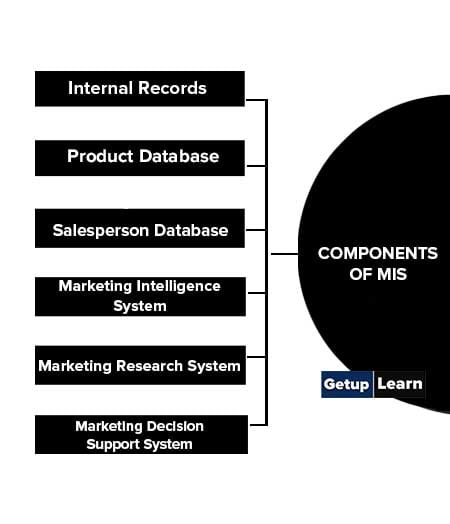
Internal Records
With its internal records of sales data, customer database, product database, financial data, operational data, etc., the Organization will collect information. A comprehensive explanation of the internal data sources is given below:
Information may be obtained from records such as invoices, copies, and billing documents prepared by businesses upon receipt of the order for products and services from consumers, distributors, or sales representatives The latest sales information acts as an assistant to the Marketing Information System should be maintained on a regular basis.
Present sales and inventory level reports help managers decide on their objectives, and marketers may use this data to design their potential sales strategy. Companies maintain many databases, such as the Consumer Database, in which the full information on the name, address, phone number, purchasing frequency, financial status, etc. of the customer is kept.
Product Database
Product database in which full information about the price, features, and variations, of the product is stored.
Salesperson Database
The salesperson database, wherein the complete information about the salesperson, his name, address, phone number, sales target, etc. is saved In the data warehouse, the companies store their data from where the data can be retrieved whenever the need arises.
When the data is stored, it is mined by statistical experts by applying many computer software and techniques to turn it into usable meaningful information that offers facts and figures.
Marketing Intelligence System
The marketing intelligence system provides data on market events, i. e. marketing environment-related data that is external to the organization. It includes information on changing market trends, the pricing strategy of the competitor, changes in the tastes and preferences of the customer, new products launched on the market, the competitor’s promotion strategy, etc.
In order to have an effective marketing information system, companies should work aggressively by taking the following steps to enhance the marketing intelligence system:
- Providing the right training and encouraging the sales force to keep track of market trends, i. e. changing customer tastes and preferences, and providing suggestions for improvements if any.
- Motivating the partners of the channel, i. e. dealers, distributors, distributors in the real market to provide the appropriate and required customer and competitor details.
- Companies can also strengthen their system of marketing intelligence by having more and more competitor knowledge. This can be achieved either by buying the product of the competitor, visiting trade shows, or reading the written papers of the competitor in magazines, journals, or financial reports.
Marketing Research System
Marketing Research is the systematic collection, organization, analysis, and interpretation of primary or secondary data to find out solutions to marketing problems. By applying various statistical instruments, businesses perform marketing research, including shifts in the tastes and desires of the client, competitor tactics, the reach of new product launches, etc.
The data, which can be either primary data (first–hand data) or secondary data(second–hand data, available in books, magazines, research reports, journals, etc. ), must be obtained in order to perform market research.
Marketing Decision Support System
It requires many software programs that can be used to evaluate the information gathered so far by marketers to make better marketing decisions. The marking managers can save the huge data in a tabular form with the use of computers and can apply statistical programs to evaluate the data and make decisions in line with the results.
Therefore, marketers need to check the marketing environment, i. e. both the internal (within the organization) and the external (without the organization), so that it is possible to plan marketing practices, processes, and strategies accordingly.
Types of MIS
A management information system is a broad term that incorporates many specialized systems. The major types of MIS:
- Executive Information System (EIS)
- Marketing Information System (MIS)
- Business Intelligence System (BIS)
- Customer Relationship Management System (CRM)
- Sales Force Automation System (SFA)
- Transaction Processing System (TPS)
- Knowledge Management System (KMS)
- Financial Accounting System (FAS)
- Human Resource Management System (HRMS)
- Supply Chain Management System (SCM)
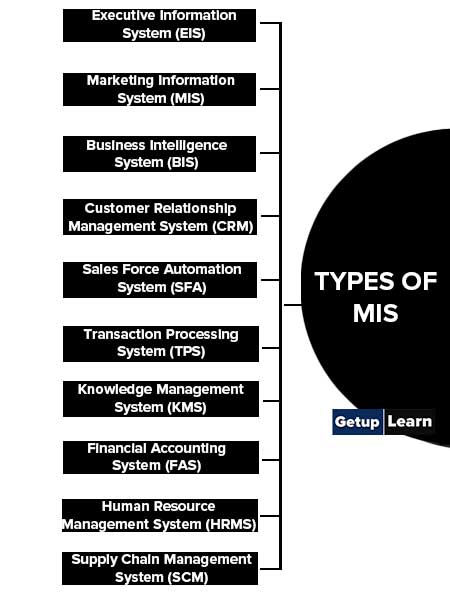
Executive Information System (EIS)
Senior management uses an EIS to make decisions that affect the entire organization. Executives need high-level data with the ability to drill down as necessary.
Marketing Information System (MIS)
Marketing teams use MkIS to report on the effectiveness of past and current campaigns and use the lessons learned to plan future campaigns.
Business Intelligence System (BIS)
Operations use BIS to make business decisions based on the collection, integration, and analysis of the collected data and information. This system is similar to EIS, but both lower-level managers and executives use it.
Customer Relationship Management System (CRM)
A CRM system stores key information about customers, including previous sales, contact information, and sales opportunities. Marketing, customer service, sales, and business development teams often use CRM.
Sales Force Automation System (SFA)
A specialized component of a CRM system that automates many tasks that a sales team performs. It can include contact management, lead tracking, and generation, and order management.
Transaction Processing System (TPS)
An MIS that completes a sale and manages related details. On a basic level, a TPS could be a point of sale (POS) system or a system that allows a traveler to search for a hotel and include room options, such as price range, the type, and a number of beds, or a swimming pool, and then select and book it. Employees can use the data created to report on usage trends and track sales over time.
Knowledge Management System (KMS)
Customer service can use a KM system to answer questions and troubleshoot problems.
Financial Accounting System (FAS)
This MIS is specific to departments dealing with finances and accounting, such as accounts payable (AP) and accounts receivable (AR).
Human Resource Management System (HRMS)
This system tracks employee performance records and payroll data.
Supply Chain Management System (SCM)
Manufacturing companies use SCM to track the flow of resources, materials, and services from purchase until final products are shipped.
Functions of MIS
MIS is set up by an organization with the prime objective to obtain management information that is to be used by its managers in decision-making. Thus, MIS must perform the following functions in order to meet its objectives. Following are the functions of MIS:
- Data Capturing
- Processing of Data
- Storage of Information
- Retrieval of Information
- Dissemination of Information
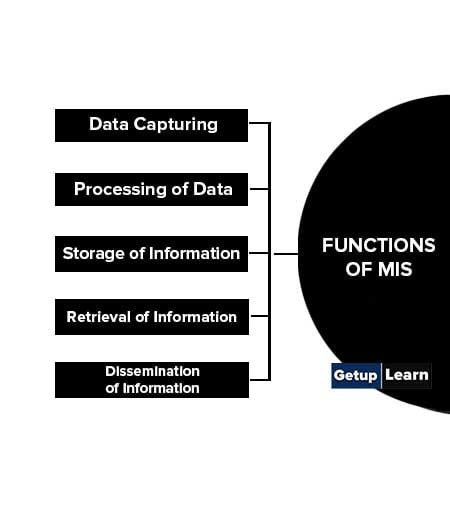
Data Capturing
MIS captures data from various internal and external sources of an organization. Data capturing may be manual or through computer terminals. End users typically record data about transactions on some physical medium, such as paper form, or enter it directly into a computer system.
Processing of Data
The captured data is processed are converted into the required management information. Processing of data is done by such activities as calculating, comparing, sorting, classifying, and summarizing. These activities organize, analyze and manipulate data using various statistical, mathematical, operations research, and/ or other business models.
Storage of Information
MIS stores processed or unprocessed data for future use. If any information is not immediately required, it is saved as an organizational record. In this activity, data and information are retained in an organized manner for later use.
Stored data is commonly organized into fields, records, files, and databases, all of which will be discussed in detail in a later chapter.
Retrieval of Information
MIS retrieves information from its stores as and when required by various users. As per the requirements of management users, the retrieved information is either disseminated as such or it is processed again to meet the exact MI demands.
Dissemination of Information
Information, which is a finished product of MIS, is disseminated to the users in the organization. It could be periodic through reports, or online through computer terminals.
Advantages of MIS
Let’s understand the advantages of MIS:
- Organized data collection.
- A broad perspective.
- The storage of important data.
- An avoidance of crises.
- Coordinated marketing plans.
- Speed in obtaining sufficient information to make decisions.
- Data amassed and kept over several time periods.
- The ability to do a cost-benefit analysis
The disadvantages of a Marketing information system are high initial time and labor costs and the complexity of setting up an information system.
Marketers often complain that they lack enough marketing information or the right kind, or have too much of the wrong kind. The solution is an effective marketing information system.
Difference Between MIS and Marketing Research
These are the basis of differences between MIS and marketing research:
- On Basis of Meaning
- On Basis of Purpose
- On Basis of Scope
- On Basis of Nature
- On Basis of Reports
- On Basis of Orientation
- On Basis of Problems
- On Basis of Data
- On Basis of Operation
- On Basis of Computers
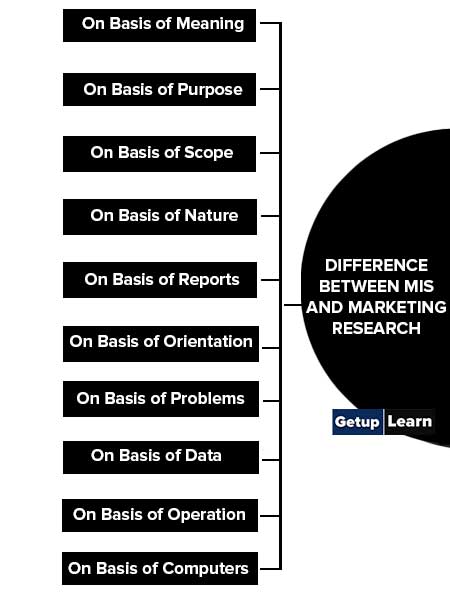
On Basis of Meaning
MIS means to collect, analyze and supply relevant marketing information to the marketing managers. The marketing managers use this information for taking effective marketing decisions. It is a permanent and continuous process.
Marketing Research (MR) is a systematic process of collecting and analyzing information to solve a specific marketing problem.
On Basis of Purpose
The main purpose of MIS is to provide relevant information to marketing managers and enable them to make effective marketing decisions.
However, the main purpose of Marketing Research (MR) is to solve a specific marketing problem.
On Basis of Scope
The scope of MIS is wide. Marketing Research (MR) is one of its components. It is not only used to solve problems but also helps to prevent problems in the future.
The scope of Marketing Research (MR) is narrow. It is one small part of MIS. It solves a specific present marketing problem.
On Basis of Nature
MIS is more nonspecific or general in nature. It can solve many types of marketing problems.
Marketing Research (MR) is more specific or particular in nature. At one time, it can only solve a single type of marketing problem.
On Basis of Reports
MIS gives four types of reports namely, plan reports, periodic-reports, triggered reports, and demand reports.
Marketing Research (MR) provides only one report called as ‘MR Report.’
On Basis of Orientation
The orientation of MIS is more future-oriented when compared to MR.
However, the orientation of Marketing Research (MR) is more past and present when compared to MIS. It concentrates more on the earlier and the latest information. It uses this information to solve a current marketing problem.
On Basis of Problems
MIS deals with and attempts to solve many different marketing problems at one time. For this, it collects, stores analyzes, and supplies relevant market information to the marketing managers.
Marketing Research (MR) only deals with a single marketing problem at one time. It doesn’t solve multiple marketing problems simultaneously.
On Basis of Data
In MIS, the data is collected more frequently, usually almost daily. This is a must for every company.
In Marketing Research (MR), the data is not collected as frequently as in MIS. It is collected on a required basis.
On Basis of Operation
MIS is a permanent and continuous system. Here, the inflow of market information never stops. Data is constantly collected and stored for further analysis. It is properly analyzed, studied, and well-organized before supplying to the marketing managers. MIS has a starting but no ending point.
Marketing Research (MR) is not a continuous system. Here, data is collected only when a company faces a specific marketing problem. It has a starting and ending point.
On Basis of Computers
MIS is heavily based on the use of computers. Here, computing technologies are widely used to ease and facilitate data collection, storage, analysis, retrieval, and supply of relevant information to marketing managers of the company.
Unlike MIS, Marketing Research (MR) hardly makes use of computers. It uses computers only for analyzing some information and is not entirely based on computing technologies.
What is marketing information system?
A marketing information system (MIS) is a continuing and interacting system of people, equipment, and procedures to gather, sort, analyze, evaluate, and distribute pertinent, timely, and accurate information for use by marketing decision–makers to improve their marketing planning, implementation, and control.
What are the components of MIS?
Following are the components of management information system:
1. Internal Records
2. Product Database
3. Salesperson Database
4. Marketing Intelligence System
5. Marketing Research System
6. Marketing Decision Support System.
What are the types of MIS?
Following are the types of management information systems:
1. Executive Information System (EIS)
2. Marketing Information System (MIS)
3. Business Intelligence System (BIS)
4. Customer Relationship Management System (CRM)
5. Sales Force Automation System (SFA)
6. Transaction Processing System (TPS)
7. Knowledge Management System (KMS)
8. Financial Accounting System (FAS)
9. Human Resource Management System (HRMS)
10. Supply Chain Management System (SCM).
What are the functions of MIS?
Following are the functions of marketing information systems:
1. Data Capturing
2. Processing of Data
3. Storage of Information
4. Retrieval of Information
5. Dissemination of Information.
What are the advantages of MIS?
Following are the advantages of marketing information systems:
1. Organized data collection.
2. A broad perspective.
3. The storage of important data.
4. An avoidance of crises.
5. Coordinated marketing plans.
6. Speed in obtaining sufficient information to make decisions.
7. Data amassed and kept over several time periods.
8. The ability to do a cost-benefit analysis.
What are the difference between MIS and marketing research?
MIS means to collect, analyze and supply relevant marketing information to the marketing managers. The marketing managers use this information for taking effective marketing decisions. It is a permanent and continuous process.
Marketing Research (MR) is a systematic process of collecting and analyzing information to solve a specific marketing problem.

